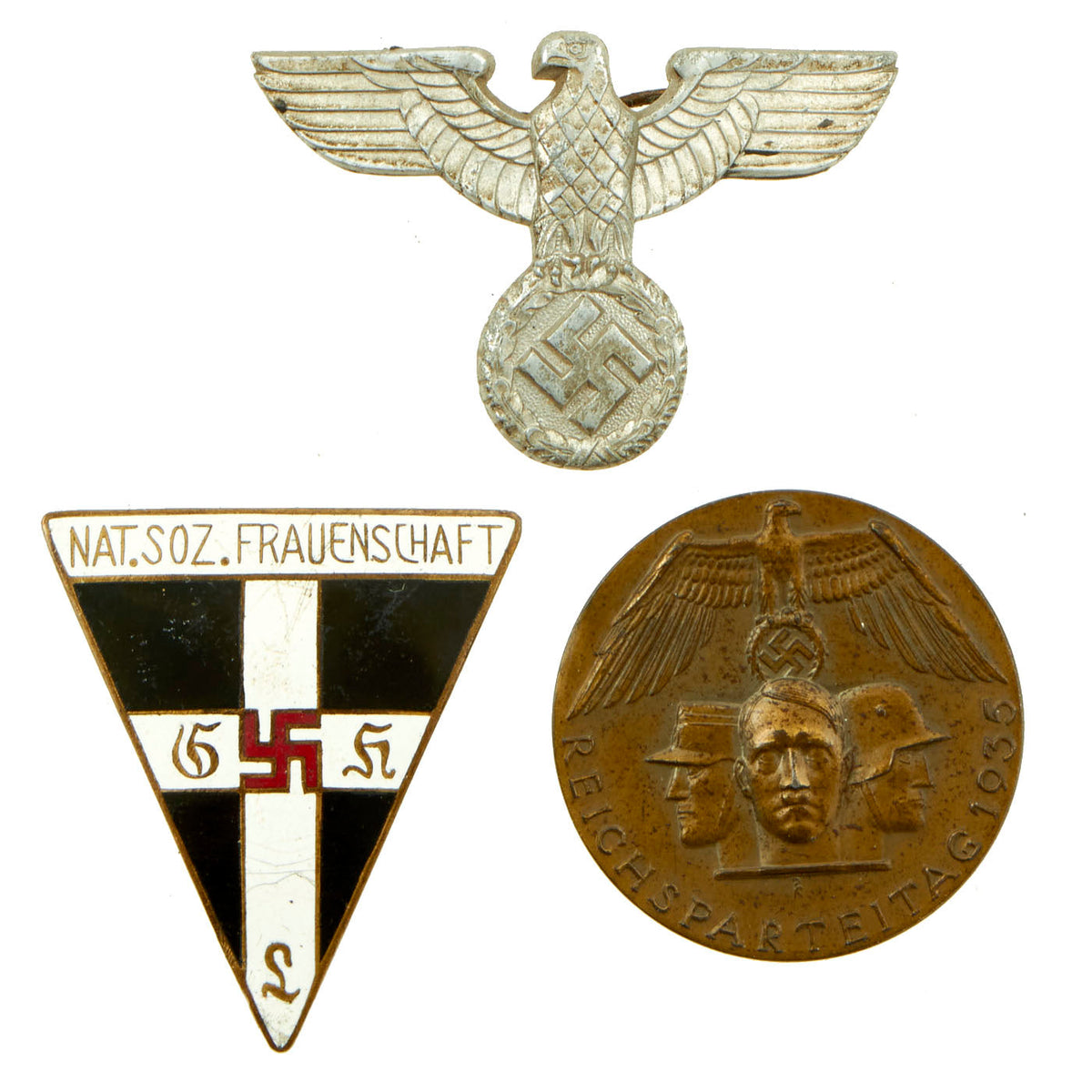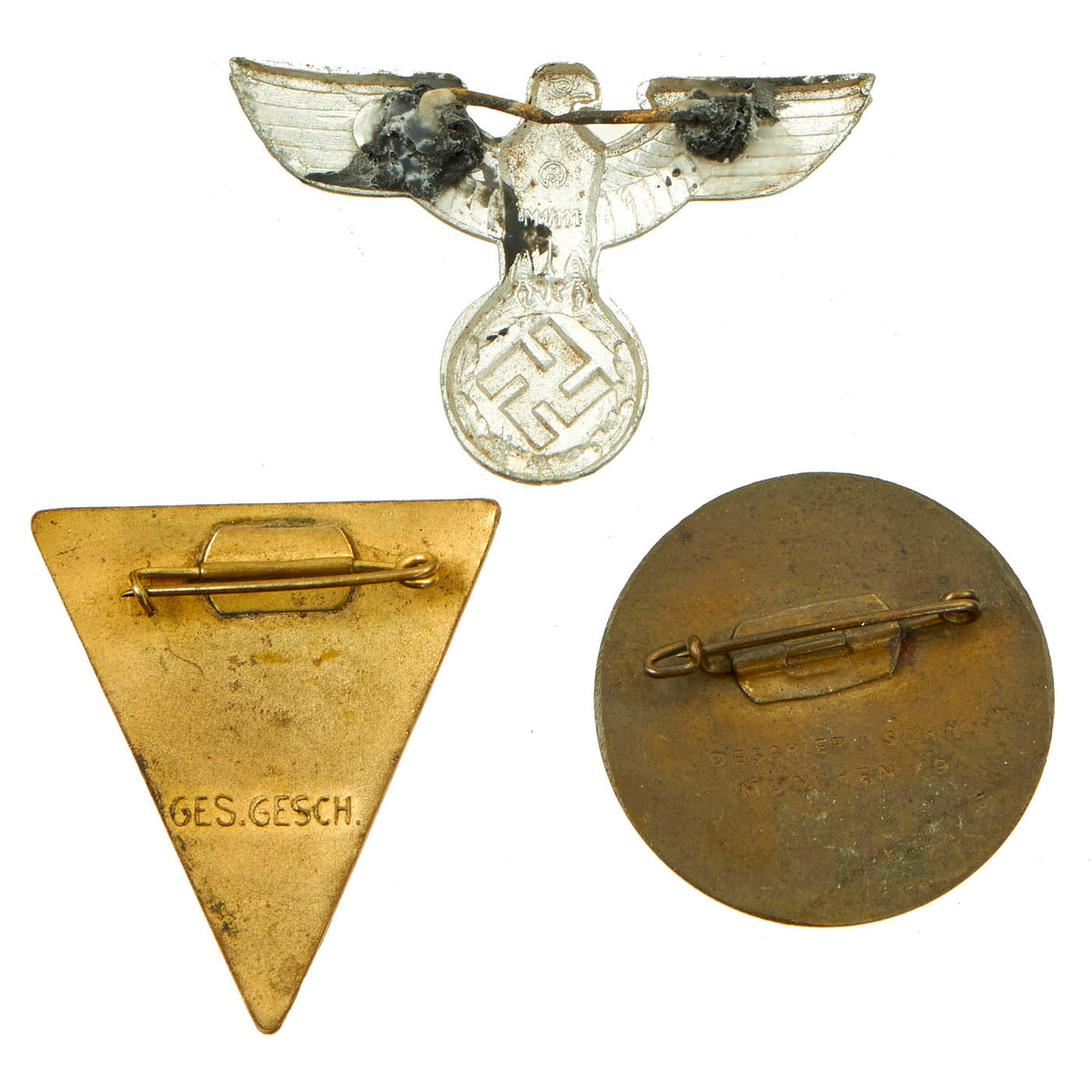Original German WWII Medal and Insignia Lot – 13 Items Original Items
$ 225,00 $ 90,00
Original Items: Only One Lot of 13 Available. This is a wonderful lot with a beautiful assortment of items. This is perfect for the younger collectors just starting out or the salty collectors wanting to add more items to their collection.
The items in this lot:
– Social Welfare Medal: On May 1ST 1939, AH introduced a series of four Social Welfare awards to replace the earlier DRK, Deutsche Rote Kreuz, (German Red Cross) awards. The earlier DRK awards only recognized loyal service in the DRK while the new Social Welfare awards recognized a wider scope of social welfare service. The new Social Welfare awards could be bestowed to all personnel who actively participated in Social Welfare assistance programs including the DRK, the WHW, Winterhilf Werk, (Winter Relief Program), personnel involved with the care of the sick and wounded, live saving services, excluding Fire and Police personnel and care of German nationals in foreign countries. In December 1939 amendments of the introductory order decreed that the bestowal of the Social Welfare awards to military personnel follow a specific rank level structure with the first class award reserved for General ranks, the second class award for the ranks of Oberst and Oberstleutnant, the third class award for the ranks of Major and Hauptmann and the fourth class for award to the ranks of Leutnant or below. Further amendments of January 30TH 1942 introduced crossed swords cypher for the third and fourth class awards for distinguished service or bravery in wartime. Of Note: After the introduction of the Social Welfare awards personnel who had previously been bestowed a DRK award retained the right to wear it or replace it for a Social Welfare award of the same grade.
The medal is a Fourth class, die struck zinc/alloy award. The roughly 38mm diameter, circular award features the embossed Social Welfare emblem of a Greek style cross with slightly textured arms with a stylized national eagle with down-swept wings superimposed to the center of the obverse on a plain field background. The reverse of the award features embossed Gothic script on a plain background field, “Medaille für Deutsche Volkspflege”, (Medal for German Social Welfare). The medal ring and ribbon suspension ring are complete. Medal has a War Merit Cross ribbon attached for some unknown reason.
– KvK 2nd Class With Swords and Ribbon: The War Merit Cross was a state decoration of NSDAP Germany during World War II. By the end of the conflict it was issued in four degrees and had an equivalent civil award. A sanitized version of the War Merit Cross was reissued in 1957 by the Bundeswehr for its veterans.
This award was created by Adolf H in October 1939 as a successor to the non-combatant Iron Cross which was used in earlier wars (similar medal but with a different ribbon). The award was graded in the same manner as the Iron Cross: War Merit Cross Second Class, War Merit Cross First Class, and Knights Cross of the War Merit Cross. The award had two variants: with swords given to soldiers for exceptional service “not in direct connection with combat”, and without swords given to civilians for meritorious service in “furtherance of the war effort”. Recipients had to have the lower grade of the award before getting the next level.
– Gold 1st Class Mothers Cross: The 1st class, Gold Cross was given to eligible mothers with eight or more children! Reverse of medal reads 16 December 1938, which is the date that the award was first established, along with AH’s Signature. Condition of medal rates at very good to excellent, with the original ribbon in very nice condition.
– x3 NSDAP Political Buttons: All 3 buttons are RZM stamped on the reverse and retain much of their original color.
– 1st Pattern Frauenschaft Women’s Organization Badge: An alloy and enamel badge in the form of an inverted triangle. “Nat Soz Frauenschaft” is in the white band at the top of the obverse, underneath is a white cross against a black background. To the center of the cross is a red, static swas, and “G” is to its left arm, “H” to its right, and “L” to its base. These letters signify the Frauenschaft motto, “Glaube, Hoffnung, Liebe” (Faith, Hope, Love). All of the letters, and the edges of the swas, cross, and the badge itself, are in the same color as its alloy base.
– Visor Cap Eagle: The alloy stamped eagle is RZM marked and was “repaired” for display purposes.
– 1935 Tag Der Arbeit Tinnie: Introduced in 1933, the NSDAP declared May 1st the “Day of National Work” as an official state holiday to celebrate laborers and the working classes. It is constructed out of a die struck aluminum-alloy base that has been silver washed with burnished highlights. The oval-shaped obverse depicts three men; one man has a sledgehammer over his shoulder, one has a scroll in his hands and the other has a sheaf of wheat lying over his forearm. These men are below an arched: “Tag Der Arbeit” (Labor Day) and above a national eagle, with outstretched wings clutching a wreathed swas within its talons, that is flanked by “1935”.
– 1934 Reichsparteitag Nuremberg Rally Tinnie: The 6th Party Congress was held in Nuremberg, September 5–10, 1934. It was called the “Rally of Unity and Strength” (Reichsparteitag der Einheit und Stärke). It is constructed out of a die struck steel base that has been branzed. The round shaped obverse features the torso of a dressed soldier holding a broadsword in his right hand and a shield (with a swas roundel and oak leaves on it) in his left. He is beside “1934” (to the right), “Reichsparteitag” (to the left) and above a small “RK”. The full back reverse shows a soldered on brass oval plate which holds a brass well working pin.
– 1935 Reichsparteitag Tinnie: The 7th Party Congress was held in Nuremberg, September 10–16, 1935. It was called the “Rally of Freedom” (Reichsparteitag der Freiheit). It is constructed out of a die struck steel base that has been bronze washed. The round shaped obverse depicts a bust of Adolf in front of an SA man (left) and soldier (right), all of which are below an open-winged national eagle that is clutching a wreathed swas in its talons. To the bottom there is a small “RK” and reads “Reichsparteitag 1935”.
– 1936 Reichsparteitag Tinnie: The 8th Party Congress was known as the “Rally of Honor” (Reichsparteitag der Ehre, September 8–14). The remilitarization of the demilitarized Rhineland in March 1936 constituted the restoration of German honor in the eyes of many Germans. It is constructed out of a die struck zinc-alloy base that has been silver gilded. The round shaped obverse depicts three kneeling warriors, with shields, protecting a plinth below a national eagle with outstretched wings clutching a wreathed swas within its talons and surrounded by “1936”, which is all above “Reichsparteitag”.
– Luftwaffe EM/NCOs Breast Eagle: The Luftwaffe pattern national eagle was originally introduced for wear by Fliegerschaft, (Pilot Base), personnel of the DLV, Deutscher Luftsport Verband, (German Air Sports Association), the clandestine, civilian, forerunner of the Luftwaffe on August 18, 1934 and was officially adopted for wear by all Luftwaffe personnel on March 1ST 1935. The original first pattern national eagle was utilized until a slightly modified, second pattern national eagle was introduced in late 1936 to early 1937. Regulations dictated that the national eagle was to be worn on almost all headgear and on the right breast of almost all uniforms with a few minor exceptions. Officer’s ranks generally utilized hand embroidered breast eagles as opposed to the machine embroidered breast eagles as utilized by EM/NCO ranks.
The insignia is a machine embroidered, second pattern, (Circa 1936/1937-1945) Luftwaffe eagle, clutching a canted swas in one talon, in silver/gray rayon threads on a cut-out, gray (feldgrau) wool base. The eagle is in overall excellent, unissued condition with minimal age toning.
All items come ready to display.
Fast Shipping with Professional Packaging
Thanks to our longstanding association with UPS FedEx DHL, and other major international carriers, we are able to provide a range of shipping options. Our warehouse staff is expertly trained and will wrap your products according to our exact and precise specifications. Prior to shipping, your goods will be thoroughly examined and securely secured. We ship to thousands clients each day across multiple countries. This shows how we're dedicated to be the largest retailer on the internet. Warehouses and distribution centres can be located throughout Europe as well as the USA.
Note: Orders with more than one item will be assigned a processing date depending on the item.
Before shipping before shipping, we'll conduct a thorough inspection of the items you have ordered. Today, the majority of orders will be delivered within 48 hours. The delivery time will be between 3-7 days.
Returns
The stock is dynamic and we cannot completely manage it because multiple stakeholders are involved, including our factory and warehouse. So the actual stock may alter at any time. It's possible that you may not receive your order once the order has been made.
Our policy is valid for a period of 30 days. If you don't receive the product within 30 days, we are not able to issue a refund or an exchange.
You can only return an item if it is unused and in the same state as the day you received it. You must have the item in its original packaging.
Related products
Uncategorized
Uncategorized
Uncategorized
Uncategorized
Uncategorized
Australian WWII Owen MK1 Machine Carbine SMG Custom Fabricated Replica with Sling Original Items
Uncategorized
Uncategorized
Uncategorized
Band of Brothers ORIGINAL GERMAN WWII Le. F.H. 18 10.5cm ARTILLERY PIECE Original Items
Uncategorized
Angolan Rebel 1970s era 60mm Inert Display Mortar from Angolan Civil War Original Items
Uncategorized
Uncategorized
Uncategorized
Uncategorized
Uncategorized
Uncategorized
Uncategorized
Uncategorized













































































